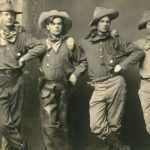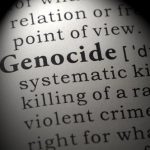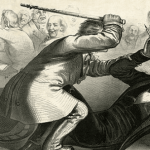 Weird Stuff
Weird Stuff  Weird Stuff
Weird Stuff  Our World
Our World 10 Ways Your Christmas Tree Is More Lit Than You Think
 Movies and TV
Movies and TV The 10 Coolest Stars to Set Sail on The Love Boat
 History
History 10 Things You Didn’t Know About the American National Anthem
 Technology
Technology Top 10 Everyday Tech Buzzwords That Hide a Darker Past
 Humans
Humans 10 Everyday Human Behaviors That Are Actually Survival Instincts
 Animals
Animals 10 Animals That Humiliated and Harmed Historical Leaders
 History
History 10 Most Influential Protests in Modern History
 Creepy
Creepy 10 More Representations of Death from Myth, Legend, and Folktale
 Technology
Technology 10 Scientific Breakthroughs of 2025 That’ll Change Everything
 Weird Stuff
Weird Stuff Ten Bizarre Facts About The Doge Meme
 Our World
Our World 10 Ways Your Christmas Tree Is More Lit Than You Think
 Movies and TV
Movies and TV The 10 Coolest Stars to Set Sail on The Love Boat
Who's Behind Listverse?

Jamie Frater
Head Editor
Jamie founded Listverse due to an insatiable desire to share fascinating, obscure, and bizarre facts. He has been a guest speaker on numerous national radio and television stations and is a five time published author.
More About Us History
History 10 Things You Didn’t Know About the American National Anthem
 Technology
Technology Top 10 Everyday Tech Buzzwords That Hide a Darker Past
 Humans
Humans 10 Everyday Human Behaviors That Are Actually Survival Instincts
 Animals
Animals 10 Animals That Humiliated and Harmed Historical Leaders
 History
History 10 Most Influential Protests in Modern History
 Creepy
Creepy 10 More Representations of Death from Myth, Legend, and Folktale
 Technology
Technology 10 Scientific Breakthroughs of 2025 That’ll Change Everything
Ten Totally Forgotten Deadly American Disasters
What do you think of when you think of awful disasters? If you’re like many of us, especially here in the United States, things like Hurricane Katrina come to mind. Or perhaps your mind will be drawn to something like the devastating 1994 Northridge earthquake in southern California. Sadly, there are so many awful disasters to think of that we certainly wouldn’t blame you if your answer was totally different… and equally as heartbreaking.
But there have sadly been many more terrible disasters than what we remember readily off the tops of our heads. And some of these totally forgotten tragedies have led to the deaths of literally thousands of people. In this list, we’ll take a look at ten of the deadliest disasters in American history that nobody seems to remember. These incidents wiped scores of people off the face of the earth and then, for whatever reason, were wiped from our collective unconsciousness.
Related: 10 Unsolved American Mysteries
10 Johnstown (PA) Flood of 1889
The Johnstown Flood of May 31, 1889, claimed the lives of over 2,000 people when the South Fork Dam, located a few miles upstream from the city of Johnstown, Pennsylvania, failed during a storm. The dam had been built in 1853 to create a lake for the wealthy members of the South Fork Fishing and Hunting Club. That club boasted some of the most prominent men in the country, including Andrew Carnegie. The dam had been poorly maintained, though. One season, heavy rainfall caused a massive amount of water to build up behind it. Eventually, the dam gave way, and the resulting flood swept down the Little Conemaugh River.
The wave was estimated to be 40 feet high and traveled at speeds of up to 40 mph (64.4 km/h). The city of Johnstown was completely unprepared for it, with no warning of the disaster. The wave swept through the city, destroying everything. The human toll was staggering, with over 2,000 confirmed dead. Many more were missing and presumed dead. The flood also caused millions of dollars in damage.
Thankfully, the response was widespread, including relief efforts led by the American Red Cross and the Pennsylvania National Guard. Beyond that, the Johnstown flood had a lasting impact on the country and helped change how the U.S. approached dam safety and emergency relief. But at what cost…[1]
9 Sea Islands (SC) Hurricane of 1893
The 1893 South Carolina Sea Islands Hurricane was a devastating storm with winds of up to 130 mph (209 km/h). A 20-foot (6.1-meter) storm surge caused widespread flooding and destruction. The storm hit the barrier islands of South Carolina, known as the Sea Islands, and completely wiped out thousands of residents. Along with it, homes, businesses, and crops were completely destroyed. Thousands more people were left homeless and without any means of support. The death toll from the storm was thought to be more than 2,000 people, but today, historians think it actually might have been even more.
The tragedy was particularly devastating for the local Black population. They had still been recovering from the economic and social effects of the Civil War and the end of slavery, and many were working as sharecroppers or tenant farmers. They couldn’t rebuild their homes and businesses after the storm. The response to the disaster was slow, too. Little aid came to the locals, and many were forced to migrate to the mainland in search of work and shelter. Many families that tried to stick it out never fully recovered. But despite the devastation, the storm did help define the American Red Cross’s early disaster response role.[2]
8 Mississippi River Flood of 1927
The 1927 Mississippi River Flood was one of the most destructive natural disasters in U.S. history. It occurred in the spring that year, after heavy rainfall and an unusually early and severe snowmelt caused the Mississippi River to overflow. For weeks, it flooded a large portion of the Mississippi River Valley. The flood caused issues from Illinois to the Gulf of Mexico, but the worst damage was in Mississippi, Arkansas, and Louisiana. It claimed the lives of more than 1,000 people and left hundreds of thousands more completely homeless.
The flood also destroyed property, infrastructure, and agriculture. The high waters swept away thousands of homes, washed out roads, and destroyed thousands of acres of cotton and corn. The federal response was slow, and the states quickly became overwhelmed.
The flood also had a significant impact on the Black community, who were disproportionately affected by it. They lived in the flood-prone areas and were vulnerable to the rising waters. Even worse, many were denied aid due to racial discrimination. In the flood’s aftermath, the government expanded its control over river infrastructure and flood management, including new levees and dam systems along the Mississippi.[3]
7 Heppner (OR) Flood of 1903
On June 14, 1903, a heavy rainstorm caused Willow Creek, a small tributary of Oregon’s John Day River, to overflow its banks. The flooding quickly spread to the nearby town of Heppner with no warning at all. Residents were caught completely off guard. They were unable to escape the rising waters, which reached a height of 20 feet (6.1 m) in some areas. The speed at which the water moved made it impossible for people to outrun it. The death toll quickly became staggering. Official estimates put the number at 247 dead, including entire families who were unable to escape in time.
The disaster completely destroyed Heppner. But in the aftermath of the flood, the community came together to rebuild a new town. They designed it on higher ground, so as to be safer in the face of future flooding. They also set up a series of new building codes that were meant to create stronger, more durable, and safer structures. Today, only about 1,200 people live in Heppner, but it has survived. That’s an incredible thing in and of itself![4]
6 Great October (LA) Storm of 1893
In October of 1893, a hurricane made landfall unexpectedly in Louisiana. It landed right on top of the tiny coastal village of Cheniere Caminada early on the morning of the first day of the month. The storm, which meteorologists later looked back at and determined to be a Category 4, killed 779 people and left thousands more completely homeless. And because it struck without warning, the death toll was far higher than it otherwise might have been. Winds reached up to 140 mph (225 km/h) and flattened nearly every building in the village. If that wasn’t enough, a storm surge above 20 feet (6.1 m) swept residents to their deaths out to sea.
The aftermath of the storm was even worse. With the village completely flattened and virtually no one left to speak, authorities aren’t even sure how many people died. Assumptions are that 779 (or so) were killed, but a village census hadn’t been taken in a while, and those numbers are uncertain. Some historians have hypothesized that the death toll could have been significantly higher.
The storm helped expose how unprepared governments were for major weather disasters, eventually leading to improvements in weather warning systems.[5]
5 Great New England Hurricane of 1938
The storm now known as the “Great New England Hurricane” struck the northeastern U.S. on September 21, 1938. It had formed far off in the Atlantic Ocean two weeks before and gradually strengthened as it moved north. By the time it reached New England, it had become a Category 3 with winds of 120 mph (193 km/h). It made landfall in New York on September 21, causing significant damage before moving inland, where it got so, so much worse. In New Hampshire, the storm was brutal. Some areas miles inland saw storm surges of up to 15 feet (4.6 m).
Almost immediately, it became one of the deadliest storms ever to hit the northeastern U.S., with an estimated 564 people killed across the region. Many of these deaths were caused by the storm surge and flooding, while others were due to fallen debris. The economic impact was also severe, with an estimated $308 million (equivalent to about $5.4 billion today) in damages. New Hampshire eventually rebuilt its affected cities… but slowly. Today, the storm remains a legend in the minds of many New England natives.[6]
4 Great Midwest (MI) Wildfires of 1871
The Great Midwest Wildfires were a series of devastating infernos that ripped across Michigan in October of 1871. They destroyed the cities of Holland, Port Huron, and Manistee, as well as other nearby towns. Over several days, more than 500 people were killed, and thousands of homes and buildings were completely wiped out. Experts still don’t exactly know what caused the fires. Still, they have narrowed it down to a few things: high winds, a long drought, and a large amount of dry brush and timber in a local logging area combined to create a veritable tinderbox. As the fires took hold, winds picked up to higher than 60 mph (97 km/h).
Holland was the town most severely affected. Its entire downtown area was destroyed, and literally overnight, 3,000 people were left homeless. Because the winds were so strong and sparks were igniting everywhere, people in Holland were trapped by the fire’s unpredictable movement. It sounds unlikely if you’ve never seen it before, right? How hard can it be to outrun a fire? But sadly, hundreds of people found that out the hard way.[7]
3 Great (OH) Flood of 1913
The tragedy that became known as the Great Ohio Flood took place in March 1913 and nearly destroyed the entire city of Dayton. Heavy rainfall all spring, combined with several dam failures along the Miami River to create one of the most horrific flooding tragedies of all time. A particularly bad storm on March 23 made several Miami River tributaries overflow their banks. In turn, the Miami exploded with rushing water. Dayton got the worst of it across the 23rd and the next several days. Within hours after the storm’s worst rainfall, the city was in chaos.
As the floodwaters rushed through Dayton, more than 400 people were swept away to their deaths. As with many of the disasters on this list, thousands more people were left completely homeless, destitute, and without a single possession in the world. The number of victims left homeless was beyond staggering, too: literally overnight, well over 2,000 buildings were destroyed, and at least 50,000 people in the city had no house to call home. Eventually, state officials built new levees all along the Miami River. But the work was performed too little and too late for the hundreds who perished.[8]
2 Hoboken (NJ) Docks Fire of 1900
A terrible fire broke out at New Jersey’s Hoboken Docks on June 30, 1900. The docks, located directly across the Hudson River from Manhattan, were then a critical economic hub. And back then, it was the jumping-off point for countless passenger steamships. So thousands and thousands of people went through there on a daily basis. But that afternoon, when a fire broke out on the main dock, everything unraveled quickly. The docks were made up of wooden buildings, and the blaze soon ignited them and spread. It didn’t help that the summer heat and unusually high winds served to make things worse.
Before anybody knew it, the inferno had trapped hundreds of people in several different wooden buildings on the docks. Workers were trapped in warehouses, while would-be steamship passengers were stuck in the terminal building. Even worse, there wasn’t any proper firefighting equipment on hand, so nobody could fight the blaze in an efficient way. And many of the dock’s buildings were housing industrial equipment and products that were highly flammable on their own. The combination proved to be the recipe for a complete disaster.
It took firefighters hours to battle the inferno. By the time it was all over, more than 300 people had died, and hundreds more were injured. In the end, the tragedy forced New Jersey (and the rest of the country) to grapple with new fire regulations and procedures.[9]
1 Deep South Tornado Outbreak of 1932
Over two days in March 1932, a series of tornadoes rocked Alabama and Mississippi. Beginning on March 21, storm clouds and wind patterns were perfectly set for tornadoes to pop up all over those two states, as well as more minor dust-ups in Georgia and Tennessee. The most destructive of those tornadoes swept through Tupelo, Mississippi, on the 21st. Later rated as an F5 tornado on the Fujita scale, it killed a whopping 216 people and caused severe injuries to more than 700 other locals.
It went straight through the middle of town, too, wiping out Tupelo’s business district and most of its most densely populated residential areas. Then it raged on into the small towns of Guntown and Baldwyn, destroying those villages as well. It somehow still wasn’t done there, either. The tornado crossed the border into Alabama and wrecked the hamlets of Hamilton, Hackleburg, and Phil Campbell before finally dissipating into the sky.
Daybreak on March 22 didn’t provide any respite. That morning, several more tornadoes struck across Mississippi and Alabama and then moved into Georgia and Tennessee. Across those four states, another 52 people were killed in the tornadoes, and several hundred more were left injured. Thousands more lost their homes, businesses, livestock, and livelihoods. And remember—this was 1932. The Great Depression was in full swing. What a terrible, terrible time.[10]








